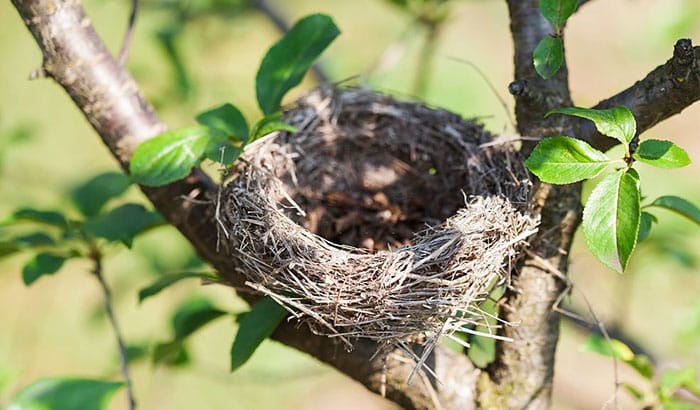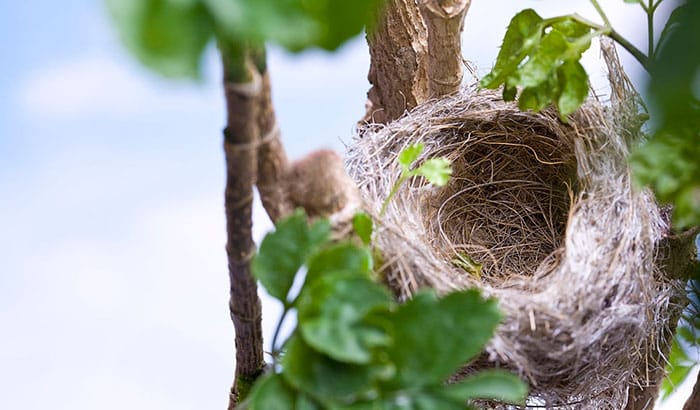Birds move places to find the perfect spot where they can build nests. While that seems to be a typical sight, it’s just so fascinating to see how they go to great lengths to do this and protect their birdlings from potential predators.
However, problems take place when you find their nests in your roof, window sills, gutters, shingles, nooks, under a patio umbrella, and any difficult places you could think of. This is no surprise since birds sometimes choose the most complex and inconvenient locations to build their nests.
If you ever caught yourself in this predicament, you’re probably thinking about two things: Is it okay to move or remove a nest? When and how should I move bird nests with or without eggs?
One thing’s for sure, it is imperative to consider bird nest situations and legal matters before you take any actions. In this way, you can protect the birds’ nests, abide by the law, as well as prevent damages to your property.
Contents
What You Should Know First About Moving a Bird’s Nest
If you’re planning on how to remove a bird nest with eggs or even those without, the following questions will help you evaluate the situation and decide whether it is proper to move a bird’s nest or not.
Are there any legal consequences when removing or moving bird nests?
It depends on the country you live in. There are some countries, including the United States of America, that mandate laws to protect a variety of bird species, even those birds that have probably been nesting in your backyard.
In some cases, if you attempt to interfere with or wreck the nests, particularly the ones with eggs in them, you’ll be penalized with large fines and other penalties. Therefore, when you see an active nest or the one that has eggs in it or has a female bird nesting, remember that it is illegal to move it.
This may also apply to situations where there are eggs in the nest but the birds or parent birds are not present. This doesn’t mean that the eggs are abandoned. You may have to wait for some time for the birds to come back. Thus, you must not move bird nests right away.
How about bird nests without eggs? Should you move it?
If you come across an empty bird nest and find no eggs in it, you can remove it carefully or relocate it to someplace else. However, there are some instances when birds reuse their nests or other birds may have already moved in.
You’ll be able to determine this based on the structure or if you notice that some birds usually come by and dwell in it. Therefore, you have to make sure that it is empty before you move or remove it.
Would birds be able to locate their nests when moved?
It depends on where you move the nest. If you move it too far from where it originally is, mama bird might not find it.
Although many bird species are typically familiar with their environment or habitat, extreme disturbance of their nest might lead mom or adult birds to neglect their nestlings or eggs. That’s why experts advise not to move bird nests unless it is immensely necessary.
When should you move a bird nest?
If the nest has no eggs in it and you’re quite sure that no other birds have moved in, you can move a bird nest. You may also consider the nest structure. If you notice that it is still in the early phase of construction, you can remove it carefully and block that spot so the birds won’t come back to build another nest.
You may consider moving a bird’s nest if it is really necessary, especially when you find them in inconvenient or dangerous places such as under a vehicle or in a backyard griller. As mentioned, you may usually find bird nests in the oddest places, and relocating them to another place would probably be the ultimate solution.
How to Move a Bird Nest With Eggs
Moving a nest with eggs can be crucial. But if you’re left with no choice and there is no possible way to contact a local rescue organization to do this or perhaps, you’ve confirmed that you’re permitted to do this, you can take the following steps on how to move a bird nest with eggs.
STEP 1: Find the bird’s nest.
The very first thing to do is to locate where the bird’s nest is. As we’ve discussed, you may find bird nests in the most inconvenient places such as the roof, gutter, downspouts, vents, under a vehicle, and many other places.
STEP 2: Gear up and apply preventive measures
While this seems to be a simple task, it is still important to gear up with proper equipment to deter any potential hazards, such as getting in contact with bird droppings and pathogens that are harmful to human health. You should consider wearing latex gloves, a waterproof coat or suit, and a respiratory face mask.
STEP 3: Remove and relocate the nest carefully
Since this is the most crucial step, you should be very careful when doing this. Use an antibacterial spritz and spray it on the nest. Gently remove the nest and transfer it to another spot nearby.
STEP 4: Tidy up the area
After removal, use a disinfectant or bleach solution and clean the area thoroughly. After cleaning, take your gloves off and throw them away immediately. Clean your mask and wash your hands thoroughly with soap and water.
STEP 5: Time to call for professional help
Since this concerns the legality of nest removal and you’re unsure of what to do, the best thing to do is seek professional help. In some cases where local rescue organizations are unavailable or out of reach, you may contact a professional exterminator to carry out this job. With their expertise, they can determine where the nests might be and perform proper procedures on how to remove nests safely.
Conclusion
To sum it up, we’ve learned four prerequisites for relocating a bird’s nest:
- It is imperative to consider the affiliated legal matters.
- You must not move a bird’s nest with eggs unless it is immensely necessary.
- You can move a nest without eggs as long as it is completely empty or unoccupied.
- Always seek professional help to relocate a bird’s nest, especially if there are eggs inside.
Birds build nests to provide a safe place for their eggs or nestlings, and we don’t want to be the predators who would ravage their homes simply because we find it inconvenient or unattractive. And if we truly care for the birds and their babies, we will take this as a serious matter and be extra careful every time.


